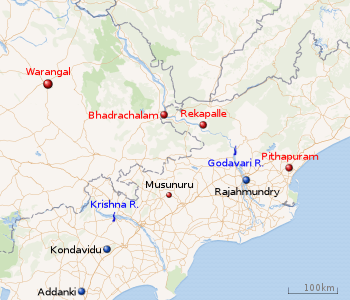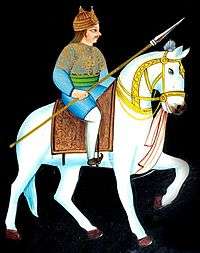Musunuri Nayakas
The Musunuri Nayakas were warrior kings of 14th-century South India who were briefly significant in the region of Telangana and Andhra Pradesh.
Musunuri dynasty | |
|---|---|
| 13th century–14th century | |
| Capital | Warangal |
| Government | Monarchy |
| History | |
• Established | 13th century |
• Disestablished | 14th century |
| Part of a series on |
| Andhra Pradesh and Telangana |
|---|
 |
| History and Kingdoms |
|
Dynasties
|
Origins
Little is known of the Musunuri family; they are often described as "obscure".[1][2] The founding ruler of the family, Musunuri Prolaya Nayaka, suddenly appears as a new ruler at Rekapalle, near Bhadrachalam, around 1330, claiming heritage from the Kakatiyas.[3]
Andhra historians often state that Musunuri Nayaks belonged to the Kamma caste group [4][5]. However, the modern castes of Andhra region did not originate until the late stages of the Vijayanagara Empire.[6]
Opposition to Turks
After the fall of the Kakatiyas, their empire was annexed by the Delhi Sultanate. Ulugh Khan (or Muhammad bin Tughluq), the general that conquered Warangal, renamed it "Sultanpur" and remained as the governor of the region for a short period. In 1324, he was recalled to Delhi to succeed the Khaljis as Muhammad bin Tughluq. A former Kakatiya commander, Nagaya Ganna Vibhudu, now renamed Malik Maqbul, was appointed as the governor of the region.[7] However, the Tughluq hold over the erstwhile Kakatiya empire was tenuous and a number of local chieftains seized effective power.[8]
Prolaya Nayaka
 |
According to the Vilasa grant, Prolaya Nayaka ruled from Rekapalle. Located at the edge of the Papikondalu hills (part of the Eastern Ghats), Rekapalle could control the narrow Sabari river valley lying between the Bhadrachalam forest and the Papikondalu forest. Konda Reddis, who populate the hill forests would have facilitated Prolaya Nayakas' rebellion against the Sultanate.[3][9] Rekapalle is also a strategic location to control or obstruct communications on the Godavari river passing through the hills.
Prolaya Vema Reddi of the Panta Reddi clan, who seems to have established his own independent rule in Addanki by 1325, is believed to have taken control of the region between the Krishna and Godavari rivers, perhaps up to Rajahmundry.[10][11] Historian M. Rama Rao states that Vema Reddi and Prolaya Nayaka must have made a 'joint effort' to drive the Muslim rule out from the area.[11]
In 1330, Prolaya Nayaka published the Vilasa grant, a copper-plate grant near Pithapuram, in which he bemoaned the devastation of the Telugu country brought about by the Turks and attempted to legitimise himself as the rightful restorer of order.[12] Prolaya Nayaka left no children and was succeeded by a cousin, Kapaya Nayaka, who governed until 1368 and attempted to further expand his rule.
Kapaya Nayaka
Rebellion

Musunuri Kapaya Nayaka (r. 1333–1368) led a larger rebellion against the Tughluq rule, driving it out of Warangal in 1336. According to the Kaluvacheru grant of Anithalli, a female member of the Panta Reddi clan in 1423, Kapaya Nayaka was assisted by 75 Nayakas. The grant also states that Prolaya Vema Reddi was one among these 75 Nayakas, but this is doubtful.[13][lower-alpha 1]
Muhammad bin Tughluq, who became the Sultan of Delhi in 1324, witnessed numerous rebellions starting in 1330, first in the immediate vicinity in the Ganga-Yamuna doab, which caused a famine in Delhi, and rebellions within ranks in Ma'bar (Madurai) and Bengal. It is possible that Kapaya Nayaka advanced in the direction of Warangal in this period, acquiring some of its territory. Consequently, Telangana was also counted among the rebellious territories.[16] In 1334–35, the Sultan marched on Deccan in an attempt to quell the rebellions, but his army was struck by some kind of epidemic and the Sultan himself fell gravely ill. He was forced to retreat to Delhi via Daulatabad. It is said that about a third of his army perished due to the epidemic.[17]
Ferishta narrates that, around this time, Kapaya Nayaka approached the Hoysala ruler Veera Ballala III for assistance in evicting the Sultanate from Warangal. After consideration, assistance was offered.
Bilal Dew [Ballala], convened a meeting of his kinsmen and resolved, first, to secure the forts of his own country. and then to remove his seat of government among the mountains. Krishn Naig [Kapaya Nayak] promised, on his part also, that when their plans were ripe for execution, to raise all the Hindoos of Wurungole and Telingana and put himself at their head.... He (Bilal Dew) then raised an army and put part of it under the command of Krishn Naig, who reduced Wurungole and compelled Imad-ool-Moolk, the governor, to retreat to Dowlatabad [Daulatabad].
Historian R. C. Majumdar characterises it as a 'national revolt' backed up by a regular army. Malik Maqbul found himself unable to withstand the rebellion and fled to Delhi.[19][20] Ferishta states that Kapaya Nayaka and Ballala III then jointly marched on the newly declared Madurai Sultanate and divested it of its outlying territories, in particular Tondaimandalam.[18][19]
Rule
Kapaya Nayaka took control of Warangal from Malik Maqbul in 1336 and thus also of a wider swathe of eastern Telangana that was governed from there. He also tried to support other rebels in the surrounding areas, although in the case of aid given to Alauddin Bahman Shah, the outcome was that his fellow rebel turned on him. Several military engagements with Bahaman Shah followed over a period of years, during which Kapaya Nayaka had to cede various forts and territories. His weakened position was exploited by the Reddis of Kondavidu and the Recherla Nayaks, the latter of whom killed him in battle at Bhimavaram.[21][22]
Despite his supposed opposition to the Turks, Kapaya Nayaka continued using the Kush Mahal built by the Turks in Warangal and adopted the Persianised title "Sultan of the Andhra country" (Andhra Suratrana). In 1361, he gifted to the Bahmani Sultan Mohammed Shah I the turquoise throne of Warangal, made during the Delhi rule, as part of a treaty agreement.[23]
Kapaya Nayaka ruled over Telangana until 1368. Upon his death, the allied Nayakas are said to have returned to their own towns, and the period of Musunuri family ended.[24]
Notes
- The Kaluvacheru grant states that Prolaya Vema Reddi became independent after the death of Kapaya Nayaka in 1368. However, it is known that Vema Reddi was already independent by 1325. M. Somasekhara Sarma recognises the mistake in the record, but nevertheless believes that Vema Reddi acted as a subordinate of the Musunuri Nayakas, while M. Rama Rao states that they bore no relation to each other.[14][15]
References
- Talbot (2001), p. 177
- Eaton (2005), pp. 26-28
- Rama Rao (1947), pp. 295–296.
-
Rao, B. S. L. Hanumantha; India), Telugu University (Hyderabad (1995). Socio-cultural history of ancient and medieval Andhra. Telugu University. p. 157.
The Nayakas of Musunuru who are said to have been Kammas . . .
-
Pramila, Kasturi (1 January 2002). Economic and social conditions of Āndhra Deśa, A.D. 1000 to 1323 A.D. Bharatiay Kala Prakashan. p. 162.
Prolayanayaka of the Musunuri family who is considered to belong to the Kamma caste established an independent kingdom at Rekapalli.
- Talbot (2001), p. 86.
- Wagoner & Rice (2001), p. 78.
- Eaton (2005), pp. 26-27.
- Hemingway (1915), pp. 4, 66–67.
- Somasekhara Sarma (1946), pp. 76–77.
- Rama Rao (1947), pp. 296–297.
- Talbot (2001), p. 178; Eaton (2005), pp. 26–27; Chattopadhyaya (1998), pp. 57–59
- Prasad (1988), p. 173.
- Somasekhara Sarma (1946), p. 81: "How this discrepancy arose and why such a wrong account was given in the Kaluvaceru grant is a mystery which is yet to be unravelled."
- Rama Rao (1947), p. 295: "It is thus impossible that Prolaya Vema could at any time have been a subordinate of the Musunuri chiefs."
- Jackson, The Delhi Sultanate 2003, p. 267.
- Jackson, The Delhi Sultanate 2003, p. 268–269.
- Somasekhara Sarma, M. (April 1931), "Kapaya Nayaka", Journal of the Andhra Historical Research Society, 5 (4): 227–228
- Majumdar, The Delhi Sultanate—Muhammad Bin Tughluq 1967, p. 76.
- Jackson, The Delhi Sultanate 2003, p. 268.
- Prasad (1988), pp. 168-172
- Talbot (2001), pp. 177-182
- Eaton (2005), p. 50.
- Talbot (2001), p. 178.
Bibliography
- Chattopadhyaya, B. D. (1998), Representing the Other? Sanskrit Sources and the Muslims, New Delhi: Manohar, ISBN 978-8173042522
- Eaton, Richard M. (2005), A Social History of the Deccan: 1300–1761, Cambridge University Press, pp. 15–16, ISBN 978-0-52125-484-7
- Jackson, Peter (2003), The Delhi Sultanate: A Political and Military History, Cambridge University Press, ISBN 978-0-521-54329-3
- Hemingway, F. R. (1915), Madras District Gazetters: Godavari (PDF), Government of Madras
- Majumdar, R. C. (1967), "Muhammad Bin Tughluq", in R. C. Majumdar; A. D. Pusalker; A. K. Majumdar (eds.), The Delhi Sultanate (Second ed.), Bharatiya Vidya Bhavan, pp. 61–89
- Prasad, J. Durga (1988), History of the Andhras up to 1565 AD, P. G. Publishers
- Rama Rao, M. (1947), "The Fall of Warangal and After", Proceedings of the Indian History Congress, 10: 292–297, JSTOR 44137150
- Somasekhara Sarma, Mallampalli (1946), History of the Reddi Kingdoms (Circa. 1325 A.D., to circa. 144B A.D.), Waltair: Andhra University
- Talbot, Cynthia (2001), Pre-colonial India in Practice: Society, Region, and Identity in Medieval Andhra: Society, Region, and Identity in Medieval Andhra, Oxford University Press, ISBN 978-0-19803-123-9
- Wagoner, Phillip B.; Rice, John Henry (2001), "From Delhi to the Deccan: Newly Discovered Tughluq Monuments at Warangal-Sult̤ānpur and the Beginnings of Indo-Islamic Architecture in Southern India", Artibus Asiae, 61 (1): 77–117, doi:10.2307/3249963, JSTOR 3249963
Further reading
- Devi, V. Yashoda (1975), After the Kākatīyas, Andhra Pradesh Sahitya Akademi
- A history of South India from prehistoric times to the fall of Vijayanagar, K. A. Nilakanta Sastri, Oxford Univ. Press, 1955.